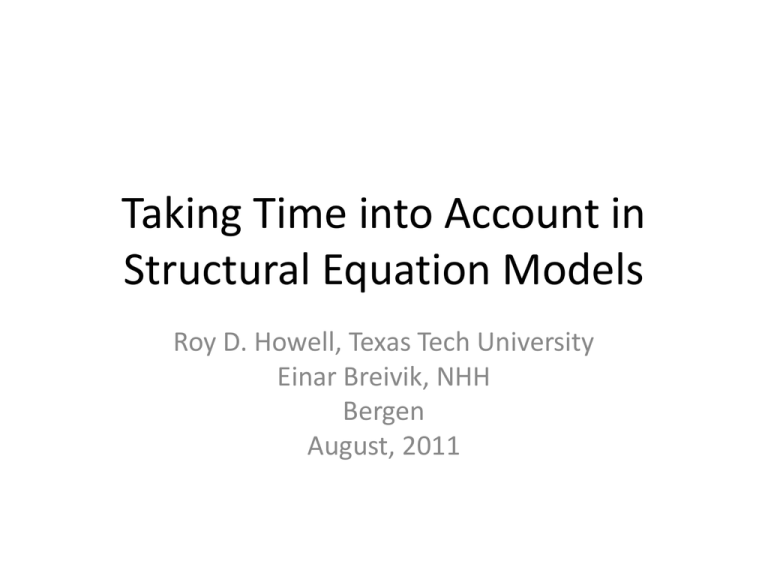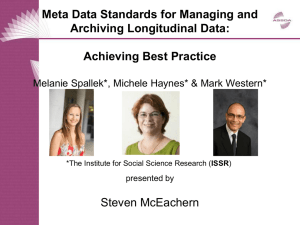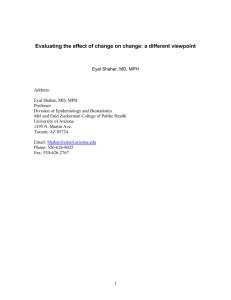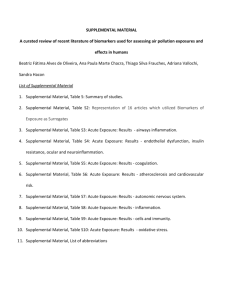Bergen 2011 - Roy Howell Homepage
advertisement

Taking Time into Account in Structural Equation Models Roy D. Howell, Texas Tech University Einar Breivik, NHH Bergen August, 2011 Every structural path in a SEM implies the passing of at least some period of time. A fundamental notion of causation : The cause must precede the effect in time. b X(t1) Y(t2) Our Question: Can we recover the true value of b (the data generating process) from a model estimated with cross-sectional data? Why does it matter? While we may carefully avoid using the word ‘cause’, since we have all been taught the “correlation does not imply causation”, it is almost impossible to avoid a causal interpretation when we get to the “managerial implications” section of a manuscript. • Cross-sectional data allow the researcher to examine how outcomes differ among entities that posses different levels of an independent variable (i.e., how profitability differs among firms with high versus low levels of market share; how information usage differs among firms with high versus low levels of trust). • The conceptual argument is based on a between-subject interpretation, consistent with cross-sectional data (i.e., covariation or correlation). • Other research focuses on how outcomes are influenced by changes in a predictor (e.g., how and increase in market share affects profitability; how and increase in trust affects information usage). The nature of the conceptual argument has a within-subject interpretation. • As noted by Rindfleisch, et al. (JMR 2008), “Of these two types of arguments, longitudinal data collection appears to be most valid for the [within subject] interpretation. Within-subject comparisons are typically obtained through multiple observations over time” (p. 276). • While the preceding statement is accurate, Rindfleisch et al. go on to suggest that, “However, most survey-based marketing studies appear to focus on between-subject arguments. Thus, for these types of studies, longitudinal data collection may not be necessary” (p. 276). • On this point we disagree. • First, it is difficult to avoid the within-subject interpretation when reaching any ‘managerial implications’. Any statement that begins “Managers should…” must have a withinsubject interpretation. • If the results of a study have no implications for actions that could be taken to affect the dependent variable of interest, then why was the study undertaken in the first place? • Even the co-authors of the paper claiming that most marketing studies are between-subject focused, in the managerial implications section, use essentially cross-sectional data (as explained later) to conclude, “Therefore, a key managerial priority should be to develop and nurture relationships with potential knowledge suppliers…” and “…a firm must develop strong relationships with key knowledge providers to gain access to knowledge” (Genasan, Malter & Rindfleisch 2005, p. 256). • Second, even in the rare event that the author of a study is very careful to express the results in betweensubject terms (e.g., firms with higher levels of relationship trust exhibit more information sharing that comparable firms with lower levels of trust; we find on average that a firm with 1% higher market share than a comparable firm will have a .6% greater ROI), how many managers will not draw the conclusion that if I increase X by one unit, I should see Y increase by b units (if I increase market share by 1% I will see ROI go up by .6% in the future); that is, draw a within-subject conclusion? • We conclude that any study designed to inform action with respect to a dependent variable must have a within-subject interpretation. • What’s wrong with interpreting an effect found from cross-sectional data in a withinsubject sense? That is, when will crosssectional estimates of longitudinal effects be unbiased? • To address this question, we need to look at some properties of longitudinal models (remember, causation implies the passage of time). Some Properties of Longitudinal Models: .4 X X 1 .4 2 .3 3 .3 .4 Y X .4 Y Y 5 .4 3 .5 X .3 .4 2 .5 4 .3 .4 1 X .4 Y 4 .5 Y 5 .5 Within-wave X,Y correlations 0 .32 .38 .40 .42 ………42 Figure 1 Example of how stationarity produces equilibrium over time. Subscripts denote the time or wave at which a given measure was obtained. Stationarity Stationarity “refers to an unchanging causal structure” (Kenny 1979, p. 232). Stationarity implies the degree to which one set of variables produces changes in another set remains the same over time. The model depicted in Figure 1 is stationary in that both the autoregressive parameters (linking a variable to itself from time period to time period) and the causal parameters are the same from wave to wave. .4 X X 1 .4 2 .3 3 .3 .4 Y X .4 Y Y 5 .4 3 .5 X .3 .4 2 .5 4 .3 .4 1 X .4 Y 4 .5 Y 5 .5 Within-wave correlations 0 .32 .38 .40 .42 ………42 Figure 1 Example of how stationarity produces equilibrium over time. Subscripts denote the time or wave at which a given measure was obtained. Equilibrium Equilibrium refers to a causal structure that displays temporal stability (or constancy) of patterns of covariance and variance. • A system that exhibits stationarity is not necessarily at equilibrium. The model in Figure 1 shows stability from the outset – the autocorrelations and causal paths are identical at every lag. However, the system is not at equilibrium until the fifth wave and after. That is, the correlation between X and Y starts at zero, and progresses steadily to and equilibrium value of .42. • We know that the true effect of X on Y is .3 in all waves. If we just had the cross-sectional correlation between X and Y at a given time, (as we would have with cross-sectional data), we would over-estimate the causal effect of X on Y (true value = .3) in every wave after wave 0, and if we were to observe the system in equilibrium (waves five and after), cross sectional data would not provide an unbiased estimate (.42 instead of .3). • Although many researchers have attempted to justify the use of cross-sectional models using the equilibrium assumption (e.g., James et al. 1985), we see that this won’t work. • So, why are cross-sectional estimates of causal effects consistently wrong? • The key here is the autoregressive effect of Yt-1 on Yt, or the effect that a variable has on itself. • Consider the Model X1 .46 .95 .23 X2 .48 Y1 .62 Y2 The true causal impact of X1 on Y2 is .23. A model for cross-sectional data gathered only at time 1 would yield an estimate of .46, while a crosssection at time to would estimate the causal effect to be .48 (Gollob & Reichardt 1987). • In this simple example, we have specification error or omitted variable bias in the equation for y2, (omitting the effect of y1). Also, If there are other factors not modeled that affect Y, some of their effect is captured in the lagged value. • It seems clear that when we investigate relationships in an ongoing system, that is, one where the variables already exist at some level for the subjects, the level of a variable at any time ti depends at least in part on its level at ti-1. A Small Example • In arguing against the necessity of longitudinal data, Rindfleisch et al. (2008) present results from two surveys conducted in two waves each. They compare cross-sectional correlations (between Xt1 and Yt1) with the Xt1,Yt2 correlations for 12 pairs of variables and conclude, “…these results indicate that the longitudinal data in each study provide largely similar results as their cross-sectional counterparts” (p. 270). But what have their results shown? • That their systems are in equilibrium (as might be expected, since the average duration of the systems they examine is over five years. • The relationships they examine are between Xt1 and Yt1 as compared to Xt1 and Yt2. What have they not considered? • The probability that Yt2 depends not only on Xt1, but also on Yt1; that is, the autoregressive effects. • While they do not present the Y1Y2 correlations, we can effectively “bracket” the magnitude of the true effect by assuming plausible values for the Y1Y2 correlations. • For example, they show that the cross-sectional correlation between Product Knowledge (PK) at time t1 with Product Creativity (PC) at t1 is .37, and the correlation between PKt1 and PCt2 is .38 (in their alliance data). • Let us assume that a plausible range for the autocorrelation of PC is from .5 to .8. At .5, the PK1 to PC2 path would be .23 (instead of .38 assuming zero autocorrelation), while at .8 the path would be .09. • This approach is consistent with the “latent longitudinal analysis” suggested by Gollob & Reichardt (1987). Does it Matter? • Both the within- versus between-subject interpretations of our data and the need to account for autocorrelation can have profound effects on practice. • Buzzell et al. (1975) – Cross-sectional PIMS data – 10% point difference in market share associated with 5% difference in ROI. • Should be interpreted as between-subject: “firms with higher market share are more profitable than low share firms”. • Strategic Planning Institute: “Market share Boosts productivity”. Based on this withinsubject interpretation (and underlying experience curve rationale), the “wars for market share” began. • Managers and consultants interpreted the findings as, “If I increase my market share I will increase my profitability,” that is, in a causal, within-subject sense. • Jacobson & Aaker (1985) – Longitudinal PIMS data, include lagged ROI in profit equation (capturing unmeasured influences on ROI). – Market share effect dropped from .5 in cross-section to .22 in longitudinal analysis. – Additionally including lagged values for market share dropped the estimate to .18 (and controlling for other variables dropped it to .03). • Ten years of business preoccupation with market share with no positive results! What to Do? • Longitudinal Data – Difficult and costly • If stability and equilibrium can be assumed, two (appropriately spaced) waves may be enough • Web-based surveys – lower marginal cost of data collection? In cases where only cross-sectional data are possible, Gollub and Reichardt (1987) recommend the use of “latent” longitudinal models. The idea is to use unobserved variable in place of time 1 variables: LX1 γ1 ø X2 β Y2 LY1 γ2 Ovals are unobserved, rectangles are observed. LX1 γ1 X2 β ø LY1 Y2 γ2 We have four parameters to estimate, but only the X2Y2 correlation is observed. γ1 can be considered a test-retest correlation – plausible values not too difficult. We can perhaps get plausible values for a test-retest on Y,(ρyy). Then the relationship γ2 = ρyy – βø can be used as a constraint to identify the system. Further, if the system is at equilibrium, the observed X2Y2 correlation should be close to the time I estimate of ø. Choosing a range of plausible values for the test-retest retest correlations, one can estimate a range of plausible values for β, the causal parameter of interest. Almost always closer to the true value than the cross-sectional correlation, and assumptions are explicit! A note on equilibrium • How long does it take? Simulation on a wide variety of autoregressive and cross-lagged parameters suggest stationary systems often approach equilibrium after four or five waves. • Systems may not be stationary, however, and may not reach equilibrium in any finite number of waves. (CSR year to year) Mediation Models? • Just as direct causal effects need time to manifest themselves, the effects of X on a mediator M need time to appear, and the effects of M on Y also require some time interval. • As in the case of a two variable system, the estimation of the true causal effect of X on M requires that the autocorrelation effect of M on itself needs to be included (as well as the Y autocorrelation). • A longitudinal mediation model is: X X 1 a M 1 3 X t a M … M M 1 2 b Y X 2 … 3 t b c Y 2 Y 3 … Y t When can a cross-sectional model of mediation (below) be used to approximate the longitudinal model? X C’ Y t t a’ b’ M t eM eY • Will a’ in the cross-sectional model provide an unbiased estimate of a in the longitudinal model? No. As in the two variable case, omitting the autocorrelation of M on itself results in omitted variable bias – M1 is a cause of M2, and is correlated with X. • Will b’ = b? No, for the same reasons we have been discussing: Y(t-1) is missing as a predictor, and is correlated with M. • Even if there is complete mediation [c=0], the crosssectional analysis will almost never reflect the longitudinal [ab] effect accurately. That is a’b’ almost never equals ab (Maxwell & Cole 2007). • Will c’ = c (the direct effect of X on Y, not mediated by M). • Assume that in the true model, c=0. • C’= 0 iff pxx = pmm (Equal Stability) • C’> 0 iff pxx > pmm • C’< 0 iff pxx < pmm • You get the appropriate direct effect in cross-sectional models ONLY when X and M are equally stable! • Maybe this is why cross-sectional models almost never demonstrate complete mediation. Does this mean I have to have three waves of data to estimate a mediation model? • Not necessarily. Measure X, M, and Y at two waves. • Estimate the a parameter (X1 to M2) with M1 in the model. • Estimate path b (M1 to Y2) with Y1 in the model. • Use the stationarity assumption (b doesn’t change from wave to wave). Then, the product (ab) can provide an estimate of the mediational effect of X on Y through M. Other Considerations • Timing of the waves is important, and deserves a level of consideration beyond the scope of this presentation. • Too long an interval, effects decay. • Especially difficult because the appropriate interval for the X to M effect may not be the best for the M to Y effect. • Using retrospection instead of a first wave? – Measurement error and response effects may be difficult to overcome. • With multiple observations on each subject (true panel or multiple (four or more) waves), latent growth curve modeling or random effects (two-level) modeling may be more appropriate. Key References • Cole, D. A. & Maxwell, S. E. (2003). “Testing mediation models with longitudinal data: Questions and tips in the use of structural equation modeling”, Journal of Abnormal Psychology, 112 (4), 558-577. • Gollob, H. F. & Reichardt, C. S. (1987). “Taking account of time lags in causal models”, Child Development, 58, 80-92. • Maxwell, S. E. & Cole, D. A. (2007). “Bias in cross-sectional analyses of longitudinal mediation.” Psychological Methods, 12 (1), 23-44. • Rindfleisch, A., Malter, A., Ganesan, S. & Moorman, C. (2008). “Cross-sectional versus longitudinal survey research: Concepts, findings, and guidelines,” Journal of Marketing Research, 45 (June), 261-279.










